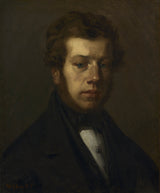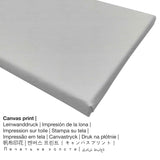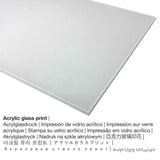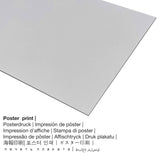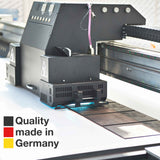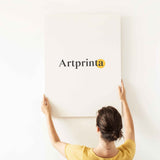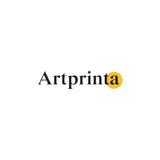Jean-François Millet, 1840 - Monsieur Martin - mbipụta nka mara mma
Ụtụ gụnyere. Mbupu gbakọrọ na ndenye ọpụpụ.
(© - Ụlọ ihe ngosi nka nke Cleveland - Velọ ihe ngosi nka nke Cleveland)
Millet and the other members of the Realist movement were renowned for not only producing realistic images, but for typically injecting their pictures with political, spiritual, or social messages. Sensitive to the human psyche and the rise of the bourgeoisie, Millet used a simple, almost monochromatic background to focus attention on the face of Monsieur Martin, a middle-class veterinarian and meat inspector. Indeed, Martin's beard, hair style, clothing, even his common French name, and the fact that he could afford portraits of himself and his wife (now lost) convey that he belonged to the prosperous middle class. This small portrait shows Millet's extraordinary skill as a painter. He depicted the highlights on Martin's face by adding patches of flat, unblended color, and some of the brushstrokes suggest the loose, quick movement of the artist's hands over the canvas.
Ozi gbasara ngwaahịa ebipụta
The nkà nke oge a masterpiece mere site na onye n’ezie master Jean-François Millet in the year 1840. The 180 years old piece of art was made with the size of Nhazi: 68 x 59,7 x 10,8 cm (26 3/4 x 23 1/2 x 4 1/4 na); Edebereghị: 46 x 38 cm (18 1/8 x 14 15/16 na). Mmanụ na akwa ákwà was used by the French artist as the technique for the piece of art. The masterpiece has the following text as inscrption: signed lower left: millet. Moveover, this artwork is included in the Ụlọ ihe ngosi nka nke Cleveland collection, which is one of the leading museums worldwide that builds, preserves, studies, and shares its outstanding collections of art from all periods and parts of the world, generating new scholarship and understanding, while serving as a social and intellectual hub for its community. We are pleased to reference that this masterpiece, which belongs to the ngalaba ọha is provided with courtesy of The Cleveland Museum of Art. : Arịrịọ nke Noa L. Butkin. Ọzọkwa, nhazi nke mmepụta dijitalụ bụ Eserese ma nwee oke nke 1: 1.2, nke pụtara na ogologo bụ 20% mkpụmkpụ karịa obosara. Jean-François Millet was a painter, whose art style can mainly be classified as Realism. The European painter was born in the year 1814 ma nwụọ mgbe ọ dị afọ 61 n'afọ 1875.
Họrọ ngwa ngwaahịa ịchọrọ ịnwe
Maka ngwaahịa ọ bụla anyị na-enye nha na ihe dị iche iche. Ya mere, anyị na-enye gị ohere ịhọrọ n'ime nhọrọ ndị a:
- Aluminom dibond (ọkpụkpụ ọla): Aluminium Dibond prints are metal prints with an impressive depth effect. The non-reflective surface structure make a contemporary look. The Direct Print on Aluminum Dibond is your ideal start to art reproductions produced with aluminum. The white and bright parts of the original artwork shimmer with a silk gloss, however without any glare.
- Mbipụta kanvas: The canvas print, not to be mistaken with a painting on a canvas, is a digital copy printed on a UV direct printer. It generates the distinctive impression of three dimensionality. How do I hang a canvas on my wall? Canvas prints are relatively low in weight, which implies that it is easy to hang up your Canvas print without the support of any wall-mounts. Therefore, a canvas print is suited for any kind of wall.
- Mpempe akwụkwọ ederede (akwa akwa akwa): The Artprinta poster print is a printed canvas paper with a slightly roughened surface finish. The printed poster is best suited for placing the art replica in a custom-made frame. Please bear in mind, that depending on the absolute size of the poster we add a white margin of something between 2-6cm around the painting to facilitate the framing with a custom frame.
- Mbipụta iko acrylic (nke nwere ezigbo mkpuchi iko n'elu): An print on acrylic glass, often referred to as a UV print on plexiglass, will convert your selected artwork into lovely décor and offers a good alternative option to canvas and dibond fine art prints. The real glass coating protects your selected art print against light and external influences for many years.
Nchịkọta ihe nkiri
| aha: | Jean Francois Millet |
| okike nke onye nka: | nwoke |
| Obodo onye nka: | French |
| Ọrụ onye na-ese ihe: | onye na-ese ihe |
| Obodo obibi: | France |
| Otu nka: | omenkà nke oge a |
| Ụdị nka: | Ihe ngosi |
| Ndụ: | 61 afọ |
| Amụrụ n'afọ: | 1814 |
| Afọ nwụrụ: | 1875 |
| Nwuru na (ebe): | Barbizon |
Nkọwa ahaziri nke ihe osise
| Aha nka nka: | "Monsieur Martin" |
| Nhazi nka: | sere |
| Okwu mkpokọta: | nkà nke oge a |
| Narị afọ nka: | 19th narị afọ |
| Ekepụtara: | 1840 |
| Afọ nka: | 180 afọ |
| Usoro izizi: | mmanụ na akwa ákwà |
| Akụkụ nke ihe osise izizi: | Nhazi: 68 x 59,7 x 10,8 cm (26 3/4 x 23 1/2 x 4 1/4 na); Edebereghị: 46 x 38 cm (18 1/8 x 14 15/16 na) |
| mbinye aka na ihe osise: | signed lower left: millet |
| Ụlọ ihe ngosi nka / ebe: | Velọ ihe ngosi nka nke Cleveland |
| Ebe ngosi nka: | Cleveland, Ohio, United States nke America |
| Ebe nrụọrụ weebụ ihe ngosi nka: | Velọ ihe ngosi nka nke Cleveland |
| Ikikere nke ihe osise: | ngalaba ọha |
| Site n'aka: | Velọ ihe ngosi nka nke Cleveland |
| Ebe kredit nke ọrụ nka: | Arịrịọ nke Noa L. Butkin |
Nkọwapụta edemede
| Nkewa edemede: | nka nka |
| Usoro mmeputakwa: | dijitalụ mmeputakwa |
| Produzọ mmepụta: | mbipụta dijitalụ |
| Mmalite ngwaahịa: | German mere |
| Stockdị ngwaahịa: | a na-achọ |
| Ngwaahịa were: | art mmeputakwa gallery, mgbidi mma |
| Nhazi nka nka: | usoro eserese |
| Oke akụkụ: | 1: 1.2 - ( Ogologo: obosara) |
| Ihe: | ogologo bụ 20% mkpụmkpụ karịa obosara |
| Akwa ngwaahịa dị: | ígwè ebipụta (aluminium dibond), acrylic glass print (nwere ezigbo mkpuchi iko), mbipụta akwa akwa, mbipụta akwụkwọ mmado (akwụkwọ kwaaji) |
| Mbipụta kanvas (akwa akwa n'elu etiti ihe ndọtị) ụdị nha dị iche iche: | 50x60cm - 20x24", 100x120cm - 39x47", 150x180cm - 59x71" |
| Mpempe iko acrylic (nwere ezigbo mkpuchi iko) nha: | 50x60cm - 20x24", 100x120cm - 39x47" |
| Nhọrọ nke mbipụta akwụkwọ mmado (akwụkwọ kwaaji): | 50x60cm - 20x24", 100x120cm - 39x47" |
| Nhọrọ nke mbipụta aluminom (aluminium dibond material) | 50x60cm - 20x24", 100x120cm - 39x47" |
| Nhazi mbipụta nka: | na-enweghị etiti |
Nkwupụta iwu: We try whatever we can to depict the products as clearly as possible and to display them visually in our shop. At the same time, the colors of the print products and the print result may diverge slightly from the presentation on the device's monitor. Depending on the settings of your screen and the condition of the surface, colors might not be printed 100% realistically. Given that the art prints are printed and processed manually, there may also be minor variations in the motif's size and exact position.
© nwebiisinka | Artprinta (www.artprinta.com)

